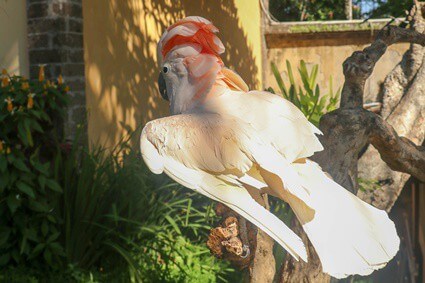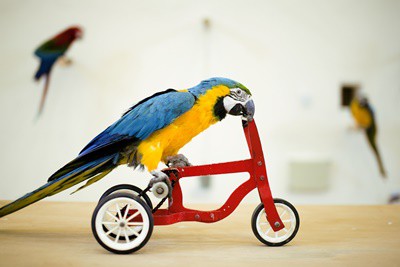Last Updated on February 22, 2024 by Carrie Stephens
Teaching parrots clever tricks enables them to utilize their high intelligence and problem-solving skills. It’s an enriching experience that alleviates boredom and prevents behavioral problems.
Parrots can learn to talk and dance if you speak and jive with them. You can teach them to “step up” or “fetch,” play dead, wave at you, talk, learn to shake hands, or poop in a specific location.
Training sessions for simple tricks take 1-2 days, while complicated tricks take months to master.
Best Tricks To Teach A Parrot
Here are some things to consider before you commence training:
- The time you have to teach the parrot, as consistent training is vital.
- Parrot species. African grays can learn more tricks than love birds.
- Distractions. If there are things in the environment, the parrot may be slower to learn.
- Basic vs. advanced tricks. More complicated tricks, like fetch, are harder to teach.
Step-up
Step-up is a gateway to several tricks. It’s complete once the parrot steps onto an object, which is usually your hand, wrist, or finger, to pick the parrot up. Here’s what to do:
- Train the parrot in a distraction-free area of the home.
- Place your finger out in front of the parrot.
- Say, “Step up.”
- Nudge your hand or finger against its legs if it doesn’t respond.
- If the parrot isn’t getting the idea, continue pressing. It may step back once or twice.
- After a few steady nudges, it’ll be compelled to step up rather than back away.
- Reward it with a treat and praise.
- Let it dismount and repeat.
After 3-4 training sessions, the parrot should recall this behavior.

Shake Hands
This trick involves the parrot lifting its foot, grasping your hand or finger, and bobbing the hand up and down. This counts as a ‘shake.’
Once a parrot knows how to step up, teaching it to shake hands involves the following:
- Hold your finger before the parrot, but don’t let it step onto it.
- Allow one of the parrot’s toes/claws to meet your finger.
- Once it does, lightly move it up and down.
- Say “Handshake,” “Shake hands,” or “How are you?”
- Provide a reward once you’re finished.
At first, the parrot won’t understand the verbal command. With practice, it’ll associate the word ‘handshake’ with the action. Then, you can tell it, “handshake,” as it performs the trick unprompted.
Wave
This trick involves the parrot lifting its foot, which resembles an adorable wave. The more advanced version has the parrot waving its foot from side to side. Here’s how:
- Hold out your finger for the parrot to step on.
- Say the word “wave.”
- When the parrot goes to step on it, take your finger away so that the foot remains elevated.
- If it’s raised its foot, praise it and give it a treat.
- The longer it holds this position, the more praise you should offer.
When you say “wave,” the parrot will lift its foot. For a more advanced version, you can add toys:
- Grab a toy the parrot likes.
- Get it to play with it for a while.
- Then, hide the toy in your hand. Ensure the parrot knows it’s there.
- Move it in an arch from one side of the parrot to the other.
- While doing this, say “wave.”
- Offer a snack when it reaches for the toy with its claw.
If you repeat this several times, the parrot will mimic the behavior on command.
Talking
Some parrot species can mimic human words. Even older parrots can learn to talk, but it’s harder.
When training a parrot to talk, repetition is vital. You need patience as the parrot learns to copy the words and phrases. Here’s how to teach a parrot to speak:
- Start by looking directly at the parrot, ensuring you have its attention.
- Say the word clearly to the parrot.
- Repeat it several times in a row. Ensure it sounds natural, as the parrot will try to say it as you do.
- If the parrot doesn’t respond, that’s okay. Continue with the training.
- When it mimics the words, be ready with praise and a snack to teach it that this is good behavior.
Here are some easy words to teach pet parrots.
Fixed Sessions
You can establish fixed training sessions where you repeat the word or phrase in 2-3 minute increments. Complete 15-20 minutes of training throughout the day.
As You See The Bird
When you see the parrot, greet it with the intended words once you have its attention. This works well for people who spend lots of time with their parrots.
Recordings
Some owners make recordings of themselves saying certain words. This can be played for the parrot when you don’t have the time to repeat phrases in person.
Play Dead
Once the parrot learns the trick, it’ll flop onto its back and hold still. After a few seconds, or when you tell it to, it’ll ‘reanimate.’ Here’s what to do:
- Ensure the parrot is on a flat surface. This should be soft or cushioned because the parrot might get enthusiastic and flop down too hard.
- Put your finger out and wait for the parrot to extend its leg forward. If the parrot knows how to step up, use the command you’ve associated with the action.
- Move your finger to the other side when it puts its leg forward.
- The parrot will likely end up on its back, trying to follow your finger.
- When the parrot is on its back, offer a treat.
A parrot may not take to this immediately because they’re prey animals.
Fetch
Parrots will fly or scurry across the floor to retrieve a toy.
You’ll need two command words for this trick: “drop it” and “fetch.” Let’s start with the first:
- Pick up one of the parrot’s favorite toys. Ensure it’s a toy it can bite, pick up, and return to you.
- With the toy in hand, hold it out to the parrot.
- Once it picks the item up, you should say, “Drop it.”
- Wait for it to drop the toy. It doesn’t know the word yet, so it may not react for a few seconds.
- As the parrot drops the toy, look it in the eyes and say, “Drop it” again.
- Give the parrot a treat so that it begins to associate that action with the command.
After it has a solid grasp on that stage, you can move on to “Fetch.”
- Take the toy and place it arm’s length away from the parrot.
- Look at the parrot and say, “Fetch.”
- Tap your hand near the toy to draw the parrot toward it. Continue to repeat “fetch” as you do so.
- Once it picks up the toy, praise it.
- Try to lure the parrot back to you verbally or by tapping your finger where you want it to go.
- Once it obeys, tell the parrot, “Drop it.” Once it does, praise it and reward the parrot with a treat.
- Repeat this several times.
- If it gets the idea, start placing the toy further away.
- Continue to reward the parrot every time it fetches it.
The parrot will eventually learn to fetch objects from different distances and fetch based on whether you throw, drop, or leave the object.

Turn Around
Nothing is cuter than a parrot willing to spin on command. To teach this trick, do the following:
- Place the treat in front of the parrot, but not so close that it’s easily accessible.
- Once you have its attention on the treat, pick it up and put it behind the parrot.
- As you do this, say, “Turn around.”
- This will compel it to rotate toward the treat while listening to the command.
- Practice this several times.
Eventually, the parrot will associate the action with the command and the reward. For a more advanced version, you can start incorporating specific commands.
- Tell the parrot to “turn right” or “turn left.”
- Move the treat in the indicated direction so the parrot learns the right direction.
How Long It Takes Parrots To Learn Tricks
Depending on the complexity of the trick, it may take parrots a few days or several weeks to perfect. Don’t expect the parrot to get the idea after the first session. Some parrots will be disinterested.
According to the Journal of Comparative Psychology, parrots react to teaching much like humans. Parrots can get overwhelmed, so allow them to learn at their own pace.
Before commencing training, take the time to form a lasting bond. Parrots that love and trust their owners are likelier to do things to make them happy, increasing the probability of a successful outcome.





